Results 7,881 to 7,890 of 8492
Thread Information
Users Browsing this Thread
There are currently 12 users browsing this thread. (0 members and 12 guests)
-
07-28-2023, 01:03 AM #7881

DIY How To Make Your Own Antibiotic - Suzanne Sherman: The Most Powerful Remedies We Lost to History
DIY HOW TO MAKE YOUR OWN ANTIBIOTIC - SUZANNE SHERMAN: THE MOST POWERFUL REMEDIES WE LOST TO HISTORY

 pAnNON
pAnNON
Kobak
1064 subscribersIf you're gonna fight, fight like you're the third monkey on the ramp to Noah's Ark... and brother its starting to rain. Join our efforts to Secure America's Borders and End Illegal Immigration by Joining ALIPAC's E-Mail Alerts network (CLICK HERE)
-
07-29-2023, 12:09 AM #7882
250+ Examples of natural remedies beating pharmaceuticals
07/28/2023 // News Editors // 2.7K Views
Tags: alternative medicine, Big Pharma, Cures, goodhealth, goodmedicine, goodscience, healing, herbal medicine, Herbs, natural cures, natural health, natural medicine, natural remedies, pharmaceutical fraud, phytonutrients, plant medicine, Prescription drugs, research, truth
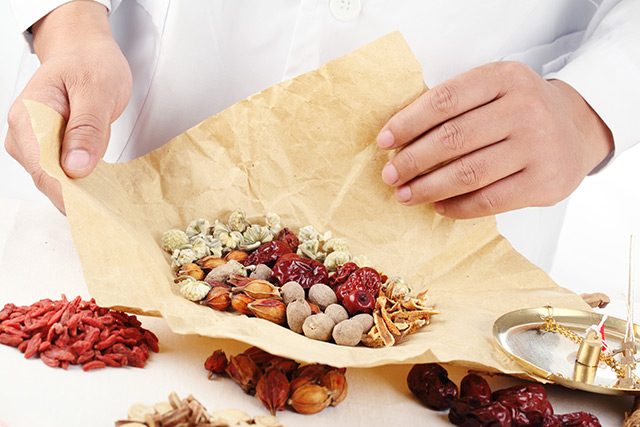
You hear a lot about 'natural healing' these days, but did you know that a sizable body of scientific literature actually supports the idea that natural medicine is safer and more effective than conventional, drug-based medicine?
(Article by Sayer Ji republished from GreenMedInfo.com)
One of the greatest if not the greatest triumph of biomedical science today is its role in validating ancient healing modalities that long before the advent of science, and even recorded history itself, were passed down "orally" from generation to generation in the vast body of folkloric medical knowledge that still forms the basis for the majority of the world's primary health care system.
These so-called "natural" or "alternative" modalities, which our species owes its present day survivorship to after eons of dependency on them, are increasingly gaining the attention of men and women in white lab coats intent on unlocking the mysteries of how they work, and in many cases, why they work better than patented, synthetic, chemical-based medications.
As you may already know, at GreenMedInfo.com, we now have over 10,000 database sections dedicated to finding scientific support for natural alternatives, with six main indexes: Natural Substances, Ailments, Therapeutic Actions, Problematic Actions, Pharmacological Actions, and Problem Substances. You'll find about 47,000 study abstracts distributed across these databases, with new research added on a daily basis. You can take the dashboard for a spin by clicking the icon below:


Check out the new GreenMedInfo Research Dashboard (a byproduct of 12 years of development)
One section, however, you will not find in the aforementioned six indexes. It is titled, “Superiority of Natural Substances vs. Drugs,” and is part of another database I am developing called Keywords, and which will be released on our site in a few weeks. These include random and salient threads of thoughts, concepts, and themes that I ran into as I gathered, curated, and indexed all the research on GreenMedInfo.com over the past seven years, but do not naturally fit into the six major indexes.
In this database Keyword alone, there are listed over 180 natural substances which have been demonstrated, mostly in preclinical research (for reasons discussed elsewhere), to be superior to their conventional drug counterparts in over 270 different diseases. Take a look at this remarkable, and always growing, resource below:

Screenshot of one of over 10,000 GreenMedInfo database nodes: Superiority of Natural Substances vs. Drugs.
We also have a section called “Natural Substances versus Drugs” with an additional 292 studies relevant to 242 diseases where there is established at least an equi-potency between the natural and conventional treatment.
It is extremely encouraging to the natural health movement to know that research actually proves the potential superiority of ancient, natural interventions versus conventional ones. The point of bringing this information to the attention of the public is to show that, at the very least, there is a legitimate place for natural medicine alongside the conventional, drug-based form, and that this is not based strictly on subjective or anecdotal experience (which is valuable), but also the scientific evidence itself, which many critics of complementary and alternative medicine (CAM) often claim does not even exist.
If you like what you see here, please consider supporting our research project by becoming a member, which provides significantly enhanced features intended to expand and optimize the evidence-base of their health practice(s) and/or advocacies. Learn more here.
Read more at: GreenMedInfo.com
250+ Examples of natural remedies beating pharmaceuticals – NaturalNews.comIf you're gonna fight, fight like you're the third monkey on the ramp to Noah's Ark... and brother its starting to rain. Join our efforts to Secure America's Borders and End Illegal Immigration by Joining ALIPAC's E-Mail Alerts network (CLICK HERE)
-
07-29-2023, 12:43 AM #7883
Survival basics: Tips for finalizing a homestead evacuation plan
07/28/2023 // Zoey Sky // 1.3K Views
Tags: chaos, Collapse, disaster, farm, farm animals, homesteading, livestock, natural disaster, off grid, panic, preparedness, prepper, prepping, prepping tips, SHTF, survival, Survival Tips, survivalist
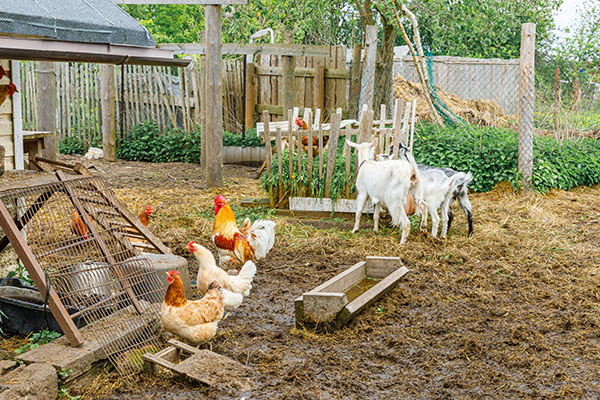
If you're one of the preppers worried about wildfire season approaching in California or other states, it might be time to finalize a homestead evacuation plan for your family and any livestock you have on your property. Doing this ensures that when SHTF and it's time to bug out or evacuate, you already know what to do and where to go. (h/t to TheOrganicPrepper.com)
Barn fires, chemical spills and other environmental emergencies can spread quickly throughout your homestead. Being ready before the smoke even rises into the air is the best way to evacuate quickly when you don't have a lot of time to prep.
You can get ready quickly if you only have a handful of people in your family, but the preparation could take much longer if you also have to worry about many animals on your farm or homestead. This is why before disaster even strikes, you need to have a plan already in place. Don't wait too long because you could endanger not only your animals and your property, but also your family.
Monitor what’s happening nearby
If you live in a state like California, check local news and other sources of information that discuss fires and other common natural disasters that could affect your homestead.
If possible, subscribe to phone notifications from the local sheriff’s department. Taking these precautions can give you a heads-up when there is a fire or mudslide nearby so you can get ready while it's still miles from your property.
With these early warnings, you can assess your plan and see if you need to take action immediately or if you just have to stay alert to safely deal with an emergency.

Fortify your barn and outbuilding
Before SHTF, here are some things to do to keep your animals safe before, during and after an emergency scenario:
- Give all animals durable and visible identification.
- Give poultry access to high perches if their coop is in a flood-prone area. Don't forget to leave them food and clean water above the potential flood line.
- Reinforce your house, barn and outbuildings with hurricane straps and other measures.
- Perform regular safety checks on all utilities, and include all buildings and facilities on your property.
Find a safe place to take your livestock
Look for a safe place to take your livestock if bringing them with you when you bug out is not an option.
Many local fairgrounds will open their facilities for farmers to bring evacuated livestock. Sometimes veterinarians and kennels will accept evacuated animals during an emergency.
Look for a local homesteading group. Talk to the members and make plans to offer a safe space for animals, trailers and RVs to help each other during fire season. (Related: Bug out survival planning: How to get out of the city after SHTF.)
Alternatively, if you are worried about a fire sweeping through your area, make plans to evacuate your animals early to a place far from the danger zone. This could give you peace of mind, especially if you only have space in your car for your family and pets.
If you want to transport your animals, you will need a trailer. You will also need pens that you can secure into the back of a truck, or crates that can hold your livestock.
If you have a lot of animals, talk to your friends so you can borrow their trailers.
Prepare a plan for last-minute homestead evacuation
In a worst-case scenario, the fire may be approaching fast and you may not be able to load up all your animals in time. Make sure you have trailers and trucks close to the livestock area for quick evacuation.
If you think you may need to evacuate, gather your livestock in the smallest area possible for easy loading. This means if your chickens are normally free-range, keep them contained in a yard around their coop so it will be easier to catch them. Close off the gates to the larger pastures and contain other livestock in the area closest to the trailers.
When you have the time, practice loading up with your livestock. This can help prepare your animals get used to being loaded, making them less likely to panic and become aggressive.
Practicing will also help you figure out which animals are going to be the most uncooperative. Lastly, it will also help you estimate how much time you need to secure your animals.
Prepare blinders, like a piece of cloth or a fabric bag. If some of the animals are panicking, it can be easier to lead them out if they have blinders on and can’t see the threat.
Blinders are often used on horses, but you can use them on skittish cows and goats too. If there is a threat like a nearby fire, animals are more likely to panic due to fear. This means it might you much longer to load them up.
Have a backup plan if you can’t evacuate the livestock
If you don't have time to load all your animals, turn them loose so they have a chance at escaping the flames.
This isn't ideal, but if it's too dangerous and your family is at risk of dying in the fire, you will have to leave your livestock behind when you evacuate. Hopefully you won't have to do this, but you should prepare yourself for a similar emergency scenario.
Prepare your homestead evacuation plan before SHTF so you know how to evacuate with your family and livestock on your farm or homestead.
Watch the video below to learn how to feed your animals for free.
This video is from the Perma Pastures Farm channel on Brighteon.com.
More related stories:
Basic survival and prepping skills that your kids should learn ASAP.
Survival 101: How to prepare for and survive a tornado.
Survival 101: How to protect your family during civil war.
Sources include:
TheOrganicPrepper.com
HumaneSociety.org
Brighteon.com
Survival basics: Tips for finalizing a homestead evacuation plan – NaturalNews.comIf you're gonna fight, fight like you're the third monkey on the ramp to Noah's Ark... and brother its starting to rain. Join our efforts to Secure America's Borders and End Illegal Immigration by Joining ALIPAC's E-Mail Alerts network (CLICK HERE)
-
07-30-2023, 01:49 AM #7884
Last edited by Airbornesapper07; 07-30-2023 at 01:53 AM.
If you're gonna fight, fight like you're the third monkey on the ramp to Noah's Ark... and brother its starting to rain. Join our efforts to Secure America's Borders and End Illegal Immigration by Joining ALIPAC's E-Mail Alerts network (CLICK HERE)
-
07-31-2023, 01:36 AM #7885
(19016) How to make Recycled paper / sawdust fire bricks - YouTube
How to make Recycled paper / sawdust fire bricks
1,460 views
Premiered Jun 27, 2021
37
Tom The English Picker
7.59K subscribersIf you're gonna fight, fight like you're the third monkey on the ramp to Noah's Ark... and brother its starting to rain. Join our efforts to Secure America's Borders and End Illegal Immigration by Joining ALIPAC's E-Mail Alerts network (CLICK HERE)
-
07-31-2023, 01:37 AM #7886If you're gonna fight, fight like you're the third monkey on the ramp to Noah's Ark... and brother its starting to rain. Join our efforts to Secure America's Borders and End Illegal Immigration by Joining ALIPAC's E-Mail Alerts network (CLICK HERE)
-
07-31-2023, 01:38 AM #7887
(19016) Free And Virtually Unlimited Fuel To Heat Your Home - YouTube
Free And Virtually Unlimited Fuel To Heat Your Home
9,849,166 views
Dec 16, 2013
38K
Tiny House Listings
937K subscribersIf you're gonna fight, fight like you're the third monkey on the ramp to Noah's Ark... and brother its starting to rain. Join our efforts to Secure America's Borders and End Illegal Immigration by Joining ALIPAC's E-Mail Alerts network (CLICK HERE)
-
07-31-2023, 01:46 AM #7888
(18974) RICHEST pan of gold EVER!!!! - YouTube
WISCONSIN
RICHEST pan of gold EVER!!!!
23,734 views
Jan 30, 2020
1K
Flour gold Wizards
37.5K subscribersIf you're gonna fight, fight like you're the third monkey on the ramp to Noah's Ark... and brother its starting to rain. Join our efforts to Secure America's Borders and End Illegal Immigration by Joining ALIPAC's E-Mail Alerts network (CLICK HERE)
-
07-31-2023, 01:56 AM #7889
Flour gold Wizards
 13:12NOW PLAYING
13:12NOW PLAYING
Time for some fan mail !!
2.4K views
18 hours ago
 21:13NOW PLAYING
21:13NOW PLAYING
Fun at the beach with our Patrons !!
8.3K views
2 days ago
 24:16NOW PLAYING
24:16NOW PLAYING
Too much GOLD ???
21K views8 days ago
 15:42NOW PLAYING
15:42NOW PLAYING
Patreon rewards !!! July 23
2.8K views
2 weeks ago
 22:35NOW PLAYING
22:35NOW PLAYING
Why does this machine catch so much GOLD ?
97K views
2 weeks ago
 18:52NOW PLAYING
18:52NOW PLAYING
My first underwater GOLD sniping trip !
22K views
3 weeks ago
 22:00NOW PLAYING
22:00NOW PLAYING
Walking on MILLIONS in GOLD !
94K views
1 month ago
 15:07NOW PLAYING
15:07NOW PLAYING
Finding GOLD with a CREW
12K views
1 month ago

18:22NOW PLAYING
Primitive GOLD prospecting !
13K views
1 month ago

23:43NOW PLAYING
GOLDEN stairway to heaven !!!!
37K views
1 month ago
 3:57NOW PLAYING
3:57NOW PLAYING
Are YOU ready for the BIG one ?
10K views
2 months ago
 18:37NOW PLAYING
18:37NOW PLAYING
Beach gold just laying there !
16K views
2 months agoIf you're gonna fight, fight like you're the third monkey on the ramp to Noah's Ark... and brother its starting to rain. Join our efforts to Secure America's Borders and End Illegal Immigration by Joining ALIPAC's E-Mail Alerts network (CLICK HERE)
-
07-31-2023, 10:52 PM #7890
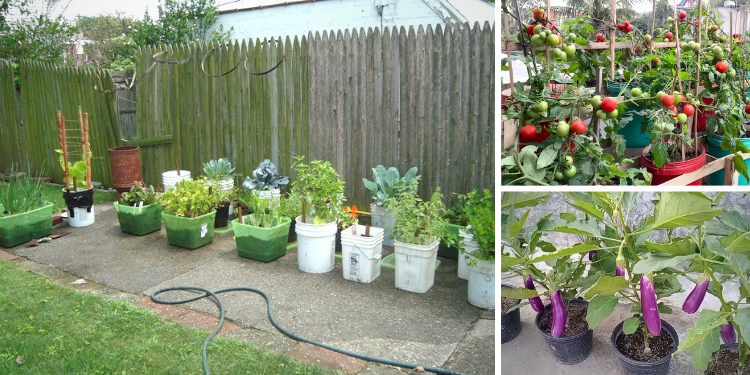
25 Crops You Can Grow In Buckets All Year Round
25 Crops You Can Grow In Buckets All Year Round
Sunday, July 30, 2023 12:58

by KATHERINE PATERSON
You don’t need fields to farm. In fact, there are many items you can grow in a bucket, allowing access to fresh farm food no matter where you live.
Container gardening has taken the world by storm. Increased populations mean less land, and abundant farming soils have developed into concrete urban jungles.
Despite this drastic change of scenery, you can still grow healthy fruits and vegetables even in an apartment.Aside from the changing landscape around us, the weather also affects our access to fresh food. Those in colder climates pay a premium for fresh fruits and vegetables shipped to local grocery stores.
Unfortunately, growing many plants outdoors is not an option for these people due to harsh, cold climates.
Thankfully, manyfoods we grow in our garden can also be grown indoors. While you probably don’t have a greenhouse in your backyard or on your balcony, chances are you can find a bucket, and that is all you need to start farming fresh food at home.
25 Crops You Can Grow In Buckets All Year Round
Many plants can be grown at home, no matter where you are located. Indoor gardens eliminate the harsh effects of the outdoor climate and allow access to fresh foods.
Creating an indoor container garden or hybrid garden is easy. All it takes is a little effort and knowledge about which plants grow best inside. Below are some plants that you can grow indoors and in containers year-round.Tomatoes
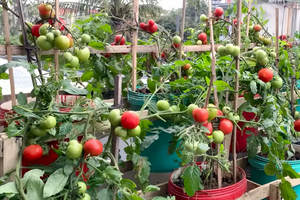 Tomatoes grow surprisingly well indoors. Since most tomato plants must be sprouted inside, keeping them indoors is convenient.
Tomatoes grow surprisingly well indoors. Since most tomato plants must be sprouted inside, keeping them indoors is convenient.
Tomatoes can be planted inside at any time of year. To extend the growing season of indoor tomatoes, plant them in September.
Kale
Kale thrives in cooler weather, making it the perfect option for container gardening. This plant does well outdoors when planted in spring and fall and is best planted indoors at the beginning of summer.
Peppers
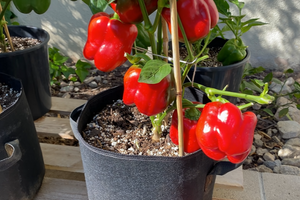 When placed indoors, peppers can be grown year-round. Planting peppers in a portable bucket allows you to move them around to aid with lower sunlight during winter months.
When placed indoors, peppers can be grown year-round. Planting peppers in a portable bucket allows you to move them around to aid with lower sunlight during winter months.
Arugula
You can grow arugula indoors and enjoy salad greens all year long. This plant needs 10-12 hours of sunlight, should be placed at a south-facing window if possible, and should be planted 3 inches apart.
Eggplant
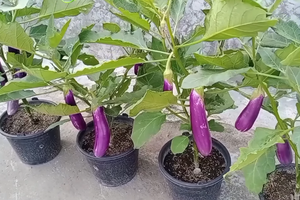 Eggplant is relatively easy to grow and does well in a container garden.
Eggplant is relatively easy to grow and does well in a container garden.
Eggplants are also a plant that continually reproduces, so you get a lot of vegetables in a little space. Since eggplants are tropical plants, you may require a heat lamp or grow light for maintenance.
Herbs
Growing herbs is easy and can save you a lot of money. Fresh herbs are more fragrant and often preferable to dried varieties. Herbs also offer a simplistic introduction to edible gardening for beginners.
⇒ Click Here To Get The 10 Medicinal Herbs You Need To Have In A Crisis
Most herbs can be grown in containers in your home, but basil, chives, mint, oregano, parsley, rosemary, and thyme tend to be the easiest to maintain and fair the best when planted inside.
Onions
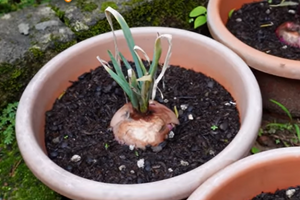
Onions are another plant that is relatively easy to grow indoors.
Ensuring they have enough space is the most crucial aspect of maintaining this plant.
Six inches of depth and three inches between each plant is best.
Depending on the type, onions also require 12-16 hours of sunlight daily. Thus, a grow light may help produce an optimal environment.
Cucumbers
Cucumbers do well indoors in a deep, hanging basket or large container. Provide the plant with at least 8 hours of sun each day and harvest when the plant reaches 10 inches in height.
Carrots
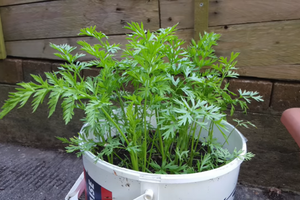
Outdoor carrots are best harvested in the fall or spring.
However, to keep carrots growing year-round, plant them indoors when winter begins and spring is coming to an end.
If you plant the carrot seeds bi-weekly, they will sprout all year.
Lettuce
You can easily grow lettuce at home and access healthy greens anytime. Lettuce can be grown in almost any container as long as there is sufficient drainage.
An easy-going, low-maintenance plant, lettuce requires very little attention and will grow in most types of soil as long as it is kept moist.
Beans
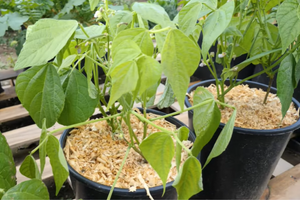
Beans make a great container plant.
They take up little space and grow well in most areas. When growing beans indoors, it is essential to ensure they get a good amount of sun.
Green Onions
One of the easiest ways to grow green onions is with a leftover onion. To do this, submerge the roots in a container of water, changing the water weekly. Once the roots reach five inches, you can move the plant to a pot of soil.
Mint
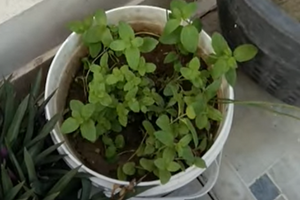 Outside, mint will grow like wildfire, and it smells incredible in the yard.
Outside, mint will grow like wildfire, and it smells incredible in the yard.
However, you can also grow mint in a container inside your house.
Mind needs to receive 4-6 hours of sun per day and has to be shielded from the hot afternoon sunlight.
Mushrooms
Mushrooms are pretty easy to grow. However, they must be placed in a cool, dark, damp space to thrive. Typically a basement, unused cabinet, or closet will work well.
Potatoes
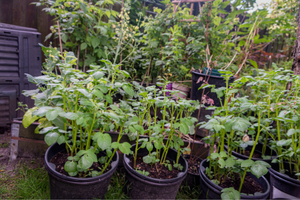
To grow potatoes inside, cut a sprouted potato into two-inch pieces, and plant it in a container of soil that has a 2.5-gallon capacity.
Potatoes grow anywhere and can be an excellent food source.
Spinach
Spinach is super healthy and easy enough to grow indoors. Plant soaked and softened seeds in a container that receives ample sunlight and keep the soil moist to benefit from this powerful vegetable all year round.
Peas
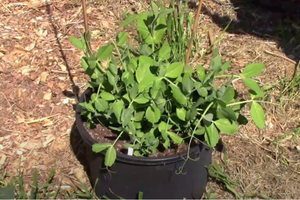
Wide varieties of peas grow well indoors, with snap peas and snow peas being the easiest to grow inside. Peas need sunlight, so they should be placed in the sunniest location of the home.
Sprouts and plants also require support. Adding a small stick to each shoot will allow them to climb and grow.
⇒ 800+ Medicinal Plants And Remedies That Might Be Growing Around Your House
Garlic
A life without garlic is no life at all. Thankfully garlic is easy to grow, and you can do it indoors anytime. To grow garlic, place 3-4 cloves in a pot of soil and sit it on a sunny window ledge. Water the plant lightly when dry and allow it to flourish.
Cabbage
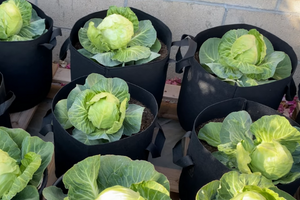
Cabbage typically grows in the fall and spring. Due to its extended growing time, cabbage does well in various temperatures.
When growing cabbage indoors, it is best to start the seeds toward the end of spring, but you can space out planting to extend the harvest.
Artichoke
Artichokes require more attention than other plants but can thrive in containers with adequate care.
The main thing to remember is that proper draining is essential, and the container must be big enough to support its extensive root system. A 5-gallon bucket will work fine for this purpose.
Squash
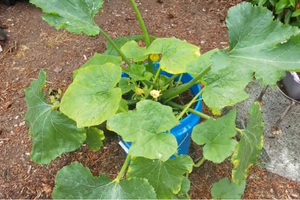 Another plant that is generally straightforward is squash. When planted in a large container with plenty of sunlight, squash can thrive indoors. It is best to choose a smaller, bush-type squash to save space, but squash plants of any type will yield a substantial harvest within about 60 days of planting.
Another plant that is generally straightforward is squash. When planted in a large container with plenty of sunlight, squash can thrive indoors. It is best to choose a smaller, bush-type squash to save space, but squash plants of any type will yield a substantial harvest within about 60 days of planting.
Radishes
Radishes have a shallow root system, making them perfect for indoor gardens. This plant also prefers when it is cool, so spring and early fall are the best times to plant. Alternatively, place the container in an area that suits the optimal conditions, and you can have radishes all year long.
Celery
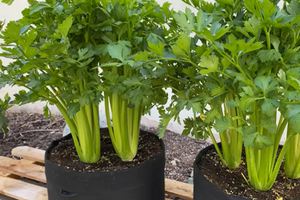 You can regrow celery using the base of a used stalk by placing it in a shallow container with water.
You can regrow celery using the base of a used stalk by placing it in a shallow container with water.
It takes about a week to see progress, and then you can move the celery to a container filled with soil.
Red Beets
Beets do well in containers but require 6-8 hours of sunlight. Place the container in front of a large, sunny window or purchase a grow light if you live in a dark, northern area.
Microgreens
Growing microgreens is increasingly popular, and many systems on the market make the process simple. The main issue with microgreens is that they often do not regrow.
Due to the micro size, all the energy they hold is used in production, and once trimmed, they must be replanted. Still, they are an excellent food source that can be grown year-round.
Although living on a farm may appeal to you, it is not always possible. However, that does not mean you can not live a sustainable, self-sufficient lifestyle wherever you are in the world.
You can grow food inside your home to provide sustenance and security. The list above is not comprehensive, and I would love to hear what you grow in containers at home.
25 Crops You Can Grow In Buckets All Year Round
If you're gonna fight, fight like you're the third monkey on the ramp to Noah's Ark... and brother its starting to rain. Join our efforts to Secure America's Borders and End Illegal Immigration by Joining ALIPAC's E-Mail Alerts network (CLICK HERE)


 210Likes
210Likes LinkBack URL
LinkBack URL About LinkBacks
About LinkBacks




 Reply With Quote
Reply With Quote





Report: White House Considers Inviting Gaza Palestinians as...
05-01-2024, 04:27 AM in General Discussion